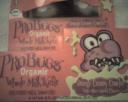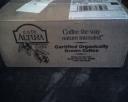And The Best Way to Raise a Healthy Eater…
A while back I blogged about “10 Tips for Raising Healthy Eaters — Even Away From Home.” Much to my chagrin, it occurred to me later that I had actually forgotten the most important tip.
Involve your kids in cooking. Teach them to cook. Or if that’s not your forte, sign them up for cooking lessons.
The sooner kids learn that food is a creative process – that it’s something you make, not something you get from a box – the sooner they’ll start to really appreciate food. This means they’ll naturally gravitate towards real, healthy food, as opposed to processed foods. (And yes, there’s plenty of processed organic food nowadays too!)
Have you taught your kids to cook? I can’t wait till they can do all the cooking! Works for me!
— Lynn
Copyright 2008 OrganicMania
Filed under Food, Green Ideas & Stuff, Parenting, Tips | Wordpress Comments (2) |“It’s Not Organic, But It’s Made in Vermont”
“What does that mean?” I asked DH who returned from a jaunt to Whole Foods where he was tasked with picking up some organic, fair trade chocolates.
“I don’t know! I’m in OrganicManiac Hell!,” he sighed in exasperation. “Doesn’t ‘Made in Vermont’ mean its good”?
What a brand image for the state! Kind of like “Paris fashion,” perhaps?
So I checked out the label on the Lake Champlain bunny he brought home. He’s right – it’s not organic, but there are no hydrogenated oils or corn syrup, and no preservatives.
Maybe it’s true – if it’s made in Vermont, it has to be good!
— Lynn
Copyright 2008 OrganicMania
Filed under Food, Holidays, Organic Product Needs, Parenting, Tips | Wordpress Comments (2) |Remembering the Edible Schoolyard
Last week OrganicMania published a series of posts about “How to Get Organics and Healthier Foods into the Schools.” A comment from MamaBird led to today’s guest post, where she writes about her time teaching at a school with one of the nation’s most progressive school lunch programs. What else would one expect from Berkeley, California?
In my students’ minds, the crisp lettuce in the field we skipped through on our journey was just as fascinating as the computers that waited amidst the stacks of books at our local library. It was 1998, and most of the young men and women loping
past the garden had no access to computers at all (many had just arrived in the country). But it was the vegetables that held their attention. On a field trip with an English Language Learner class, I couldn’t help but marvel at the audible excitement and interest over the garden and its teen gardeners. Teacher Patti Rathwell got her students into King’s school kitchen routinely, brought food into the class to illustrate
everyday concepts, and the students’ families brought in delicacies representing cuisines from all over the world to mark special celebrations. Speaking over a dozen languages, the premium form of communication among our students was laughter,
gesture, and the anticipation of flavor.
In 1998, I was a student teacher from UC Berkeley’s MUSE Program apprenticed to two classrooms at Martin Luther King Middle School. The nascent Edible Schoolyard
program, started in 1996 by a collaboration between Chez Panisse and the school
(via the Chez Panisse Foundation), was thriving by the time I landed at King. As I recall, the kids called it the “Peace Garden” and every one of the kids I taught, from
middle school second language learners ranging from 6th to 8th grade, to the 8th
graders in my humanities class, was itching to get their hands dirty. You could almost see the infusion of energy into the crops. These kids were fascinated with what their peers were creating, with their bare hands and brains. They longed to be longed to be outdoors, to work with the soil. But even more, they longed to be in the kitchen, chopping and slicing and mixing and…eating! I’ve never seen such a worthwhile channeling of teen squirm in all my life.
I’ve been thinking about the Edible Schoolyard recently, as I face the reality of
public school lunches here in DC for my daughter and her friends. I’m heartened by the fact that Berkeley, and other schools like Wisconsin’s Appleton Central Alternative School (ACAS), have adopted programs harnessing the power of
delicious and satisfying food to improve not just health but performance. Lunch
Lessons: Changing the Way We Feed Our Children, by Ann Cooper and Lisa Holmes, is a riveting book that chronicles success stories like the Edible Schoolyard and
Appleton’s ACAS, while giving parents concrete suggestions: healthy recipes and contact info for organizations working to effect change in lunch programs.
One school that’s crafted a school environment rich in healthy food and a focus on physical education is Appleton’s ACAS (which banned vending machines and instituted fruit-and-vegetable rich breakfasts and lunches). Appleton has quantifiably documented the impact of providing “nonchemically processed foods that are low in fat, salt, and sugar, as well as fresh fruits and vegetables.” Improvements seen include: more focused on-task behavior, increased cognitive development,
fewer health concerns, fewer discipline problems, better attendance, and better nutrition outside of school.
Wouldn’t it be great if all of our schoolchildren (many of whom rely on school
breakfast and lunch programs as their primary source of nutrition) got a side of nutrition education and sustainable agriculture with their salad bar lunch?
Where to look for more info about transforming your own school? Check
out the following organizations for ideas.
The Center for Ecoliteracy, Lunch Lessons, Better School Food, Food for Change, and Farm to School.
Copyright 2008 MamaBird
Filed under Biodynamic food, Food, Parenting, School lunches | Wordpress Comments (5) |Part 2: How to Get Organics and Healthier Food into the Schools
As we all know, shopping for organics and fresh produce for our own households can be complex. Just imagine the challenge of supplying an entire school system with farm fresh foods. According to activists interviewed by OrganicMania, this is one of the key reasons so many public school systems nationwide have resisted parents’ entreaties for more farm fresh and organic foods in the schools.
Check out this ABC News interview with Two Angry Moms who agitate for improvements in the nutritional content of school lunches.
[youtube]http://www.youtube.com/watch?v=-yjQgxZrEQ4[/youtube]
Last year, parents in my community agitated for change in the school menus. Their efforts were detailed in the media here. Yet when I looked at the school menu last week, I saw no evidence of change.
I called Mike Tabor, a farmer who was one of the activists quoted extensively in media coverage of last year’s school menu meetings. He told me that with last week’s Maryland Senate passage of “Farm-to-School” legislation, there is hope that farm fresh foods will soon be available to in public schools throughout Maryland.
It always takes community involvement to enact change. Clearly that’s the case with school lunches. What can you do?
Check out these resources:
Two Angry Moms Resource Page for School Lunch Change
Please send me your stories of success with improving school lunch quality. And check back next week for a guest column from Mamabird, who as a school teacher, saw first-hand what it was like to bring farm fresh produce into the public school system.
Please read Part 1 of this series too!
— Lynn
Copyright 2008 OrganicMania
Filed under Food, Organics, Organics vs. Conventional Foods, Parenting, School lunches, Tips | Wordpress Comments (2) |Organic “Kid Marketing”– Feeling the Onslaught?
So long, Tony the Tiger. Hello, Peter the Probug.
I’ve posted here about how my son recognizes “Kid Marketing” at the grocery store as the hydrogenated oil and sugar-laden processed treats that are major no-nos.
Suddenly, it’s getting a lot harder to say “no” to “Kid Marketing,” because my son also recognizes the USDA Organic Seal. Now he says sweetly, “But Mama, it’s organic! It must be good for you even if it is Kid Marketing.”
And most times, he’s right…the “Organic Kid Marketing” products may still be good for him, but they often cost several times the price of conventional organics, which are already expensive enough!
I imagine that if my kid wouldn’t eat anything healthy at all, I might welcome the overtures of the organic kid marketers. But since he was doing fine with regular old organics, the organic kid marketing hype is an annoyance.
Is anyone else sharing my feelings of resentment at the onslaught of Kid Marketing at the organic grocers? It used to be that organic shops were a refuge from Tony the Tiger, Lucky the Lucky Charms Leprechaun and all the other Kid Marketing icons. I could take my son with me to the organic market, buy a carton of yogurt, some bulk oatmeal, and be done with the shopping with a minimum of fuss and whining.
But I knew I was in for it last week when my son breathlessly told me after school one day, “Katie has the coolest yogurt at lunch. I want some! It’s orange and it’s ORGANIC!”
At the organic market that afternoon, he pointed at a garish orange four-pack of Lifeway Organic Probiotic Whole Milk Kefir Cultured Milk Smoothies. That particular day, I was too tired to say no …it was after all organic and it was just yogurt.
But later I realized that I already have several large containers of biodynamic yogurt in the fridge, courtesy of our CSA. And he liked that yogurt just fine. So why was he so insistent on this yogurt?
“Well, it tastes good,” he responded.
I reminded him that we had plenty of yogurt in the fridge that tastes good.
“It’s ORANGE. My favorite color,” he announced.
“And?” I prodded.
“And it has an alien on it too!”
So I’m buying more yogurt with more packaging because my son wants orange packages with aliens? (Actually, it’s Peter the probiotic bug, according to the packaging).
Look, this story is a bit embarrassing to tell, but I know I’m not alone here…am I? Tell me, what’s been your experience with “Organic Kid Marketing.” Are you starting to feel the onslaught too?
Or is it just the products that has me down? Perhaps. Why don’t the frozen vegetables come with aliens on their bags? Works for me!
— Lynn
Copyright OrganicMania 2008
Filed under Food, Marketing, Organic Product Needs, Organics | Wordpress Comments (6) |How to Get Organics and Healthier Foods into the Schools
On Friday I had my first look at the public school my son will attend. While waiting for the open house to begin, I picked up a lunch menu. What I saw shocked me.
Pizza twice in one week? A choice of a hot dog or pizza? And needless to say, no organic milk. And this in a school district that prides itself on its “healthy choices.” McDonald’s is healthier…at least they sell salads and vegetables that are not fried!
[youtube]http://www.youtube.com/watch?v=XhG4jugEad0[/youtube]
If the schools were able to figure out how to get soda pop and candy and commercial advertising and TV into the schools, how come they’re having such a hard time figuring out how to get even a smattering of organics and healthier options into the schools?
This is part one of a series of posts about getting healthier foods in the schools. Please check back Friday for the second post in this series! In the meantime, please leave a comment and share your experiences with school lunches.
— Lynn
Copyright 2008 OrganicMania
Filed under Food, Parenting, School lunches | Wordpress Comments (4) |Six Tips for Choosing a CSA that’s Right for You
With the growing popularity of both the “eat local” and the organic movements, membership in Community Supported Agriculture (CSA) cooperatives is on the upswing. Last week’s post discussed six reasons to love a CSA, and this week we’ll cover six tips for choosing a CSA that’s right for you. After all, each CSA has its own “personality” and you’ll need to find one that fits your convictions and lifestyle, or else you may be disappointed.
Following are six factors to consider when choosing your CSA:
1. Volunteer commitments – Traditionally, CSAs have required volunteer commitments from their members. The extent of volunteer hours and obligations will vary widely from CSA to CSA. Common volunteer chores include: working at the farm, driving a delivery truck, unloading the delivery truck, bagging produce, setting up the pick-up location, and working during share pick-up hours.
2. Veggie, Ovo-lacto-vegetarian, or Carnivore? – Some CSAs offer organic meat, whereas others are completely vegetarian or ovo-lacto-vegetarian, meaning you may be able to get milk, eggs, or cheese along with your vegetarian share.
3. Local / Organic Commitment – It used to be that organic implicitly meant local, but that’s no longer the case. Generally speaking, most CSAs will have a preference for local, organic food. But what happens in the dead of winter? Unless you live in a warm climate, you’ll likely face one of two scenarios: either your CSA will ship in organic produce from warmer climes, or you’ll be subsisting on a lot of root vegetables. Some members may welcome the addition of organic oranges, while others will decry the fossil fuels used to ship them to your local CSA.
4. Communications – Leveraging communications tools such as listservs and blogs can make all the difference in the community spirit of a CSA. Is there a way for members to connect to discuss issues such as switching volunteer hours, selling shares during vacation weeks, or recipes for the obscure veggies in your latest share?
5. Delivery and/or Pick-up Hours – If you’re habitually the last person to pick up your share, you may find the pickings are slim. What are your CSA’s pick-up hours and how do they regulate the food distribution?
6. Farm Visits – Can you visit the farms that grow your food? For some members, this is the essence of joining a CSA.
When choosing a CSA, consider what’s most important to you. Typically, you’ll be dealing with a CSA for about six months, so a little upfront research will go a long way toward ensuring a happy experience.
What’s been your experience with CSAs? Please leave a comment and share!
– Lynn
Copyright 2008 OrganicMania
Filed under CSAs, Food, Organics, Where to Buy Organics | Wordpress Comments (2) |Organic Frozen Baby Food? And Bloggy GiveAways! Interview with Heather Stouffer, Founder of Mom Made Foods, LLC
Many new Moms make a list of all the things they are going to do for their baby. Making home made baby food is often near the top of that list. But a lot of these new Moms find that time gets the best of them, and they simply can’t follow-through on everything they’d like to do. So they end up like yours truly, with an unopened “frozen baby food ice cube tray” collecting dust on top of the fridge, and jars of organic baby food sitting inside the kitchen cabinets.
Now there’s another option. Back when I posted about a sale on organic baby food, I heard from several companies making frozen organic baby food. Frozen organic baby food didn’t exist five years ago when I had my first born, and last year I left the grocery shopping to Darling Husband (DH), so I wasn’t aware of this new option until I heard about it through the OrganicMania community.
Following is an interview with Heather Stouffer, founder of Mom Made(Tm) Foods LLC and another “Organic Mommypreneur” in the spirit of Karen Gurwitz of Mothers & Menus, who was interviewed here as well. OrganicMania was curious about why a mother would choose frozen baby food, and Heather was more than happy to discuss this, along with a host of other interesting issues about organics and feeding a growing baby.
OrganicMania: We all grew up eating jarred baby foods. In fact, the icon of a happy baby was the perfect little “Gerber baby food baby.” What made you decide to look beyond the conventional, beyond jarred baby foods?
Heather Stouffer: When my son Emory, who is now nearly three, was a baby, I found it difficult to find the time each day to prepare home made baby food. I couldn’t find any freshly made, store-bought alternatives that I felt good about feeding him. So I started to think about making my own brand of frozen organic children’s foods. My brother is a professional chef, and he helped and inspired me.
OrganicMania: Why did you choose to focus on frozen baby food? What is it about frozen baby food that is special?
Heather Stouffer: My goal is to produce organic food products for children that are as close to homemade as possible. Freezing is our “preservative.” Research has shown that frozen food can be as healthy or even healthier than fresh food, depending on how long it takes fresh food to get from the farm to your table. It can be quite time intensive to go from the farm to a distributor to the store produce section.
This is in contrast to frozen food, which is picked at peak harvest and then either directly frozen or gently cooked, for example, blanched, to capture peak freshness, and then frozen. Of course, if you’re talking about locally bought produce from a farmer’s market versus frozen, the frozen food might be less fresh, but still pretty close to being on par with fresh food.
But then if you compare it to jarred food, there’s a big difference. The jarring process is very intensive. In order to jar food, you need to cook it at extreme temperatures. You can actually see the color change. The food is cooked to death, and natural nutrients are lost in this process. You see the difference in the color and the loss of texture. Jarred baby food has a “yuck factor” for parents when they feed it to their babies.
I believe babies and young children starting their journey into a lifetime of eating, should be fed the very best from the start – foods that we would welcome tasting along with them.
OrganicMania: So you’re suggesting that frozen baby food tastes better and is more nutritious than jarred baby food?
Heather Stouffer: Yes, it’s sheer delight. We freeze Mom Made products immediately after they are prepared. So it tastes like I’m biting into a fresh Bartlett pear right off the tree, and it tastes like a real sweet potato. It tastes like real food that adults eat, unlike the way jarred baby food tastes.
It sounds simple but after parents taste our food, I often hear them say something like “ooh, yum, it tastes just like a real apple!” It makes me laugh because it’s as though they expected it to taste awful. The great taste of Mom Made Foods means baby has a better experience learning to eat than is typical with jarred foods. It’s better for your baby too.
OrganicMania: You could have chosen to make conventional frozen food, which still would have been a new option for babies and would have provided the taste advantage you describe. Why did you choose to make an organic baby food?
Heather Stouffer: Your baby’s first year is the most important for growth and development. Organic food is best because your baby’s brain, immune system, and hormone system are still developing. Many non-organic fruits and vegetables contain pesticides and toxins, which can affect how our little ones grow and develop. Plus, organic food is better for the environment than conventional food, because farmers use natural methods like crop rotation and composting instead of chemicals.
OrganicMania: How much does Mom Made Foods cost as compared to jarred organic baby food?
Heather Stouffer: The retail price is $3.99 for two 3.5 ounce containers. The price difference with jarred is in the quality and care we put into making each individual serving. We use only fresh ingredients in our products and do not add any fillers, preservatives or junk.
[Editor’s note: This compares to the prices noted in this post of the non-sale price of $1.05 for a jar of Earth’s Best baby food, so this would be $3.99 versus $2.10 for roughly the same quantity of jarred organic baby food].
OrganicMania: Quite by accident, I’m starting an interview series focusing on what I call “Organic Mommypreneurs.” You’re the second interview, with more to come. Why do you think so many Moms are starting organic businesses?
Heather Stouffer: I have found that the organic message hits home with many of us moms once we are pregnant and have children. All of a sudden you’re responsible for this other little person. It’s something Moms are focused on, and so we identify the gaps in the market.
OrganicMania: How do you do it all? What advice do you have about combining motherhood and entrepreneurship?
Heather Stouffer: Focus is critical. At any one time, there are 67 things that need to be done. You need to pick out the top three strategic projects that you are doing and focus on them. Then, at the end of the day, if you didn’t get to a task that impacts one of your strategic projects, you need to ask yourself, what did I get done today? It can be really difficult some days…some days more than others.
Also, I always advise other entrepreneurs to seek out and maximize the existing resources for small businesses. You need to be able to pick up the phone and call people, which can be scary sometimes. But you need to get the word out there about what you are doing and don’t be afraid to ask for help when you need it.
OrganicMania: What’s next for Mom Made Foods?
Heather Stouffer: Right now, our products are distributed in the Mid-Atlantic region, but we’re in discussions now with national retailers. We’ll be launching new products and massively expanding our distribution this year.
Update 5/29/08 — Full disclosure: Lynn’s consulting biz, Miller Strategic Marketing, is now working on an assignment for Mom Made Foods. At the time this post was written back in February, there was no relationship between us. Pretty cool, though – we met through OrganicMania and now will be working together!
Editor’s Note:
And leave a comment to win Bloggy Giveaways of a Mom Made Foods rebate coupon for $3.99, a baby spoon, and for those of you who aren’t yet convinced, my two trays of unused baby food/breast milk storage cubes – a $12 value! (I’ll even wipe the dust off the $12 price label!) I have 10 coupons to give away, so leave a comment with your address (no fears, the comments don’t show up till I enable them, so I’ll delete your address before posting your comment to the blog!) . I’ll mail the coupons out to you. The winners will be contacted by email.
Photo Credit Family Picture: Wirken Photo
— Lynn
Copyright 2008 OrganicMania
Filed under Baby, Food, Interviews, Organic Mommypreneurs, Organic Prices, Organics vs. Conventional Foods, Parenting, Pregnancy | Wordpress Comments (17) |Six Reasons to Love a CSA (They’re More than Just Kale!)
Some Community Supported Agriculture (CSA) groups have a reputation for providing their members with little more than an overabundance of kale, chard, and root vegetables with a few sprigs of parsley thrown in. CSAs, as you may know, are collectives formed to purchase a farmer’s or a group of farmers’ crops. Members share in the bounty (or the loss) and the farmers are guaranteed a set price for their crops.
While it’s true that through my recent CSA experience, I have learned I prefer chard to kale, the recent growth in the “buy local” movement and the growing popularity of CSAs means that if you join one, you’re likely to enjoy a far broader range of foods than in years past.
Following are six reasons to love a CSA (Part 1 of 2 Posts on CSAs)
1. Variety – It’s easy to fall into a rut at the market, picking the same familiar veggies and fruits every week. Through a CSA, you may be exposed to celeriac, black radish, salsify, purple top turnips, passionfruit, persimmon, kabocha squash, Jerusalem artichokes, sweet white turnips, and Big “Florida-type” avocados, in addition to those CSA stand-bys, chard and kale! Some CSAs also provide fantastic farm fresh cheese and wonderful varieties of home-baked bread.
2. Commitment – Since you are required to pre-pay for your CSA membership, you’ll likely make it a point to get your CSA share every week. C’mon, admit it. How many times have you resorted to processed or convenience food because you simply hadn’t made it to the market for something fresh?
3. Inspiration – With the abundance of new foods to experiment with, odds are you’ll have to dust off that old cookbook and take a look at some recipes for the unfamiliar produce in your share. Cooking and discovering new recipes are all part of the CSA adventure! (Check out this blog with recipes matched to shares from the Spiritual Food for the New Millenium CSA).
4. Family Learning – My kindergartner is learning about where food really comes from, how delicious fresh organic and biodynamic food tastes, and even how to carefully measure produce on the scales. As part of our volunteer commitment to our CSA, he’s also learned how to bag flax seeds and practiced counting and sorting more than 100 bags.
5. Health – Between the variety of food, the desire to cook more healthy meals at home, and the forcing function of receiving a pre-paid weekly CSA share, odds are your regular diet will become much healthier.
6. Fun – I love visiting the CSA with my children. It is a fun, relaxed escape from the surrounding urban area.
And of course, the most important reason to join a CSA is to help the environment by supporting local, organic and biodynamic farmers.
Please check out this post explaining what’s behind the biodynamic food in some CSAs, and come back next Monday for the second part in this series, which will discuss how to choose a CSA that’s right for you.
To find a CSA near you, visit LocalHarvest.org.
— Lynn
Copyright 2008 OrganicMania
Filed under Biodynamic food, CSAs, Food, Parenting, Tips, Vegan, Where to Buy Organics | Wordpress Comments (8) |The Day After Super Tuesday: Need a Good Cuppa Joe?
I was planning to post more today about green and organic alternatives for Valentine’s Day, but like many of you, I suspect, I can’t stop thinking about last night’s thrilling election returns. I don’t want to turn this into a political blog, so commenting seems off-topic. But what do we politically aware, green and organic Dems, Republicans and Independents all have in common? We’re probably all tired from staying up late last night waiting for the returns!
Now here’s where the dividing line may occur. Some of you may have sworn off coffee for health reasons. But I’ve seen just as much science showing that coffee in moderate amounts can be good for you. Since espresso has less caffeine than coffee (and I think it’s more delicious), I drink café lattes in the morning to get me going, especially on a day like today. After getting to bed at midnight, today was a three latte morning.
And if you’re looking for a good cuppa java to help you make it through the day, I’d like to introduce you to Café Altura. I love this stuff! It is biodynamic, organic, and fair trade. What’s more, as you can see from the photo, they deliver! So convenient and so delicious! And at under $11 per pound (including shipping), it’s a great buy, too! (Lest you wonder, I have no affiliation with Altura other than the fact that I drink their coffee, which my darling husband buys! In other words, this post is not a paid post or advertisement! In fact, to-date, OrganicMania has not accepted any advertising).
By the way, MamaBird at Surely You Nest had a great post about Fair Trade recently…great explanations…check it out.
— Lynn
Filed under Biodynamic food, Food, Organic Prices, Product Recommendations, Uncategorized, Where to Buy Organics | Wordpress Comment (1) |





 My StumbleUpon Page
My StumbleUpon Page



